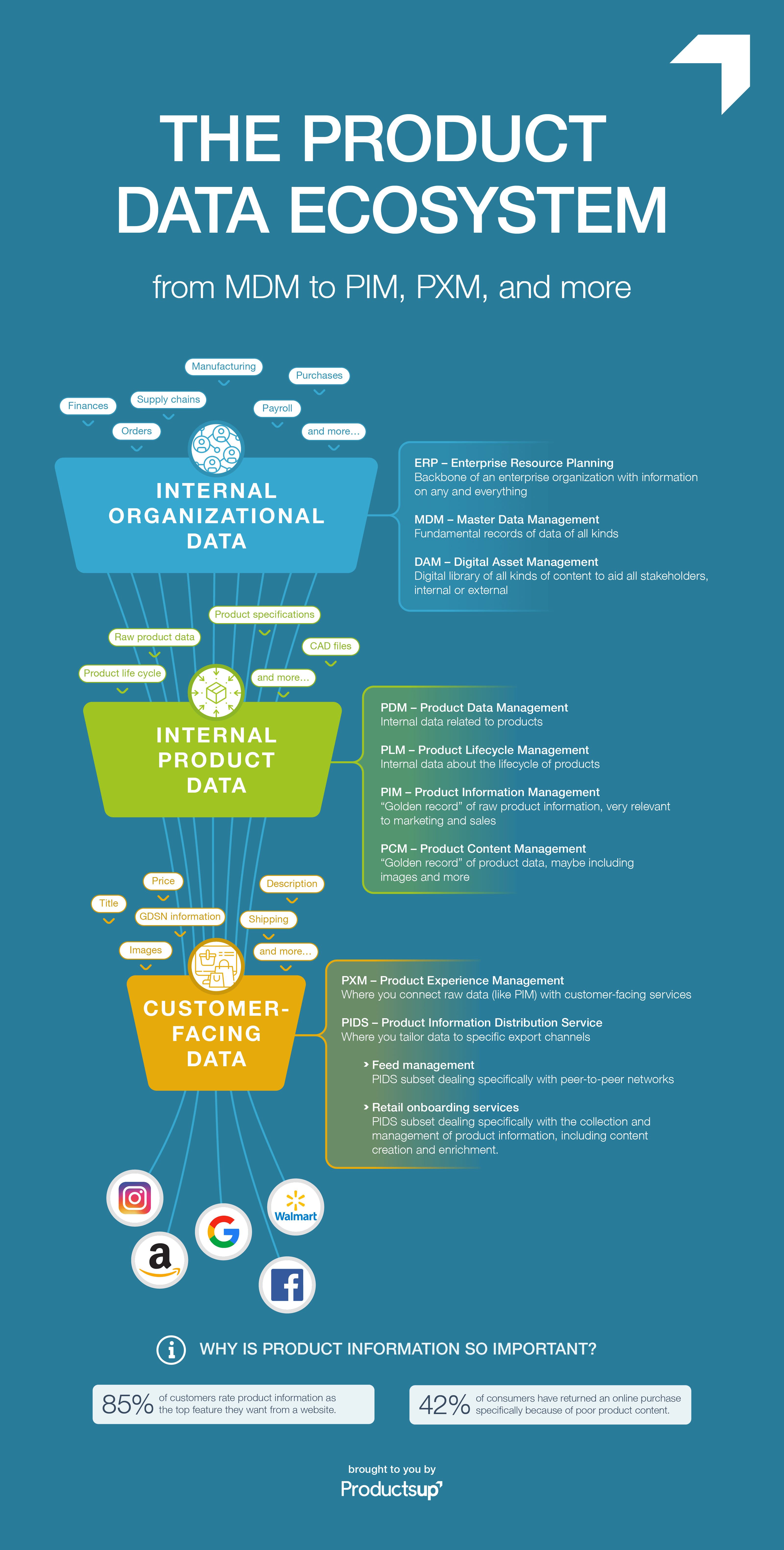Is your team using a PIM? What about PXM, MDM, or PIDS? There are so many product data-centered tools and solutions out there, you may not even know what kind your business or team is using. Let’s clear that up and take a closer look at the complete ecosystem surrounding your product data and feeds.
In order to understand the product data ecosystem, there are three key, very distinct areas to consider: internal organizational data, internal product data, and customer-facing data. Check out our infographic below, and keep scrolling for more explanation.

Internal organizational data
First things first: these are acronyms you may come across. However, while solutions and tools are still important to everyone within an organization, they won’t be directly useful for marketing or sales teams. Instead, they will usually cover internal data like supply chain, financing, or manufacturing information.
| ERP | MDM | DAM |
ERP (Enterprise Resource Planning): The backbone of an enterprise organization that facilitates the flow of information within and outside of the organization. This concerns all kinds of general data and helps consolidate all stakeholders and departments in daily operations. You may know SAP R/3 or R/4 HANA.
MDM (Master Data Management): A key central repository for all kinds of critical organizational data, including products but also contact lists and more. This is a business initiative devised to keep all data in one kind of “master file” to decrease redundancy.
DAM (Digital Asset Management): A digital library specifically for content—not just product content—where employees, clients, contractors, and other stakeholders can all have controlled access to key data.
Tip: You might also encounter the term ETL (Extract, Transform, Load). This is not a database in itself. It is rather the three steps involved in taking data from one place, preparing and sending it to a different location where it will be represented differently.
For example, when you send data from your organizational data platform to your product data platform, those two systems will likely need the data to be in different forms. ETL helps make that happen.
Internal product data
Here’s where the product data comes in. All of these solutions are designed for internal use. They help businesses manage the flow and storage of product information within the company. This is more often managed or overseen by IT rather than marketing or sales.
| PDM | PLM | PIM | PCM |
PDM (Product Data Management): Used to manage all information related to products, particularly internal information like CAD files and further documentation.
PLM (Product lifecycle management): A solution used to manage and analyze the complete lifecycle of products over time in a more strategic, rather than technical, manner. This includes information from the inception, creation, and manufacturing of a product all the way to disposal.
PIM (Product Information Management): A central repository for all raw product data including titles, descriptions, GTINs, prices, and (much) more. This is used internally to keep a clean, thorough “Golden Record” of all product data.
PCM (Product Content Management): Often considered a cloud-based “upgrade” to PIM systems, these include the ability to easily manage, enrich, consolidate, and distribute product content for specific ecommerce channels.
Customer-facing product data
Now the real fun begins! That internal product data above needs to be tailored and prepared for customer-facing export channels like Alibaba, eBay, or Facebook. This group of tools turns raw data in customer-ready data and, sometimes, to get it to the target channels. Solutions in this group can have a large amount of overlap, especially between PXM and PIDS, where solutions like Productsup tackle needs within both categories.
| PXM | PIDS | Feed Management | Retail onboarding services |
PXM (Product Experience Management): Platforms that create a link between raw product data and customer-facing venues.
PIDS (Product Information Distribution Services): Platforms with built-in capabilities to easily tailor raw data according to specific channel requirements and also transfer that product data to target channels reliably and regularly.
Feed Management: This tool is one subset of PIDS dealing specifically with peer-to-peer networks like Facebook and Google as opposed to datapools like GDSN or onboarding services.
Retail Onboarding Services: PIDS subset dealing specifically with the collection and management of product information from vendors. This often includes compliance enforcement for retailers as well as content creation and enrichment.
Note: CMS (Content management system) are systems used to manage web content, not product content. Wordpress or Squarespace are popular examples.
Content databases
Lastly, there are content databases like GDSN or Icecat. Note that this is an export channel and not a tool in itself.
Here, manufacturers can publish key information about their products for use by retailers and other sellers. This is one channel to which a PIDS, for example, could syndicate tailored product content.
How to manage product information and stay agile in this complex product data ecosystem
In order to get to grow your market shares in ecommerce, you’ll need agile product data and incredible oversight. This is what allows businesses to take advantage of new opportunities and achieve greater efficiency and ROI across all channels. Productsup helps you do all of this and more.
With Productsup, you can standardize and cleanse data, optimize for ROI, and tailor data for each and every target channel—no coding required. How does it work? Pull data straight from your PIM or aggregate it from numerous sources; then, leverage our easy-to-use rule boxes to automatically tailor each piece of data for each and every target channel; finally, syndicate that content on a schedule that works for you.
If you want to turn raw data into powerful customer-facing ads, this is all you’ll need.

![[WP Import] Your introduction to the product data ecosystem: PIM, PXM, and more [+ infographic]](http://images.ctfassets.net/q17uls4wkkdz/4bZBsYl5e8UKIbSMVyYUHu/90de5a65a0829d2e5325968027e53f61/1904-PIM_PXM_MDM_ft_image.jpg?w=1200&h=675&fit=FILL)